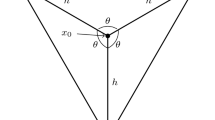Abstract
It is shown that suitable recurrences may be used in order to implement in practice the steepest-edge simplex linear programming algorithm. In this algorithm each iteration is along an edge of the polytope of feasible solutions on which the objective function decreases most rapidly with respect to distance in the space of all the variables. Results of computer comparisons on medium-scale problems indicate that the resulting algorithm requires less iterations but about the same overall time as the algorithm of Harris [8], which may be regarded as approximating the steepest-edge algorithm. Both show a worthwhile advantage over the standard algorithm.
Similar content being viewed by others
References
R.H. Bartels, “A stabilization of the simplex method”,Numerische Mathematik 16 (1971) 414–434.
H. Crowder and J.M. Hattingh, “Partially normalized pivot selection in linear programming”, IBM research report RC 4918, Yorktown Heights (1974).
G.B. Dantzig,Linear programming and extensions (Princeton University Press, Princeton, NJ, 1963).
J.C. Dickson and F.P. Frederick, “A decision rule for improved efficiency in solving linear programming problems with the simplex method”,Communications of the ACM 3 (1960) 509–512.
J.J.H. Forrest and J.A. Tomlin, “Updating triangular factors of the basis to maintain sparsity in the product form simplex method”,Mathematical Programming 2 (1972) 263–278.
D. Goldfarb, “On the Bartels—Golub decomposition for linear programming bases”, to appear.
D. Goldfarb and J.K. Reid, “Fortran subroutines for sparse in-core linear programming”, A.E.R.E. rept., to appear.
P.M.J. Harris, “Pivot selection methods of the Devex LP code”,Mathematical Programming 5 (1973) 1–28. [Reprinted inMathematical Programming Study 4 (1975) 30–57.]
A.S. Householder,The theory of matrices in numerical analysis (Blaisdell, Waltham, MA, 1964).
H.W. Kuhn and R.E. Quandt, “An experimental study of the simplex method”, in: Metropolis et al., eds.,Proceedings of symposia in applied mathematics, Vol. XV (Am. Math. Soc., Providence, RI, 1963).
J.K. Reid, “A sparsity-exploiting variant of the Bartels—Golub decomposition for linear programming bases”, to appear.
M.A. Saunders, “Large-scale linear programming using the Cholesky factorization”, Rept. STAN-CS-72-252 (Stanford University, 1972).
P. Wolfe and L. Cutler, “Experiments in linear programming”, in: Graves and Wolfe, eds.,Recent advances in mathematical programming (McGraw-Hill, New York, 1963).
Author information
Authors and Affiliations
Rights and permissions
About this article
Cite this article
Goldfarb, D., Reid, J.K. A practicable steepest-edge simplex algorithm. Mathematical Programming 12, 361–371 (1977). https://doi.org/10.1007/BF01593804
Received:
Issue Date:
DOI: https://doi.org/10.1007/BF01593804



